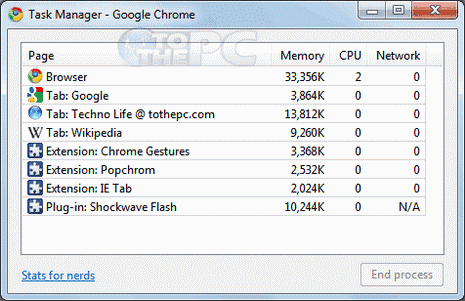1) Bookmark multiple tabs
Sometimes you want to save an entire browsing session for later reference if you need to take a break to do something else. By going to Bookmarks > Bookmark Open Pages, all of the open tabs are saved as bookmarks in a new folder. When you want to bring them back, go to the Bookmarks Manager, select all of the sites you’ve saved and then click the View button to reload them in separate tabs.

2) Go further back
Here’s a little trick you might not have come across before. Click and then hold on the back button and you get a neat little list of the recent history for the tab you’re currently viewing (it should save you a few clicks at least). If you want to see everything, then the Show Full History link at the bottom is the one to go for. The same trick works for the forward button too. Also, if you hold down Ctrl (or Cmd 0n Mac), then you can launch pages in background tabs.
3) Guest browsing
Someone wants to borrow your laptop—but you’re not keen on him or her messing around with your Facebook account or seeing the URLs that come up as suggestions in the omnibox. The answer to your problem is guest mode, which you can activate via the Enable Guest browsing tick box under People in Settings. To switch to the guest account, click on your username (top right), then choose Switch Person and Browse as Guest.
4) Use Chrome as a media player
You can use Chrome to view several of the most common video, audio, and photo formats to save you the trouble of having to install or launch a separate media player application. Chrome keeps on-screen interface elements down to a minimum, so you might prefer to open up a podcast or a movie in a browser tab, for example. Just drag and drop the file into an open tab.
5) Fit more items in the bookmarks bar
The Chrome bookmarks bar can quickly become crowded and bloated, but if you’ve pinned sites that have easily identifiable favicons you can delete the descriptions to free up space—you’ll be left with a row of compact icons to launch your favorite sites. From the bookmarks manager inside Chrome (chrome://bookmarks/), edit the relevant bookmark entries by removing everything in the Title field while leaving the Link field intact.
6) Don’t sync everything
An advantage of using Chrome is that it ties in so well with Google services and keeps all of your account information (like passwords and browsing history) synced across devices. However, you don’t have to sync everything. You might want a completely different set of extensions installed at home compared with the office, for example. From the standard Settings page, click Advanced sync settings and then Choose what to sync.
7) Double-click for word definitions
Browser extensions can add all kinds of functionality to Chrome of course, but one of the best we’ve ever come across (and one we use every day) is the Google Dictionary utility. Once installed, you can double-click on a word inside Chrome to get a definition in a pop-up window, together with a link that leads to more information if you need it. It’s invaluable for those times when you want to know what a word means without interrupting your workflow.

8) Task manager
Chrome has its own Task Manager you can call up from the More Tools menu—it shows you a list of all the open tabs and the background processes running in the browser at the moment, along with the amount of system resources they’re using up. You’ll find the Task Manager most useful when you’re trying to troubleshoot problems with the browser, and you can quickly close down a tab or process by highlighting it and clicking End Process.

9) Learn more about the sites you view
You may not have given much thought to the little icon to the left of the omnibox address bar, which can look like a padlock or a blank sheet of paper depending on the site you’re currently visiting. If you click once on it you can see a wealth of information about the page you’re on, including its security credentials, the origin of the site, the permissions you’ve previously granted it (like fullscreen mode) and the existing cookies stored by the site.
10) Do your sums in the omnibox
The Chrome omnibox has a host of secret powers. One of these is the ability to perform quick calculations and even unit conversions right from the address bar, no Google search required. Just type out a simple bit of math or something like “50 feet to inches” and the answer appears underneath before you’ve even had chance to hit Enter. Temperature, distances, and weights should all work natively, just as they do from Google searches.
(Thank you to Field Guide for the info!)
